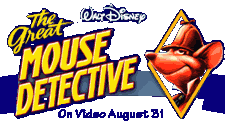

Directed by: John Musker, Ron Clements, Dave Michener,
Burny Mattinson
Written by: Ron Clements, Vance Gerry
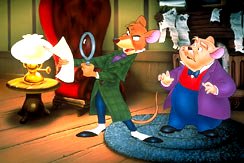 Music
by: Henri Mancini, Melissa Manchester
Music
by: Henri Mancini, Melissa Manchester
Released on: July 2, 1986
Running Time: 74 minutes
Budget: $18 million
Box-Office: $39 million in the U.S.
 Basil...
Barrie
Ingham
Basil...
Barrie
Ingham
Ratigan... Vincent Price
Dr. Dawson... Val Bettin
Fidget... Candy Candido
Olivia Flaversham... Susanne Pollatschek
Flaversham... Alan Young
Ms. Judson... Diana Chesney
Queen Moustoira... Eve Brenner
![]() Basil of Baker Street and the drunken Bartholomew is voiced brillantly
by British actor, Barrie Ingham, well known in theatre and on television,
such as Masterpiece Theatre. Mr. Ingham has been co-starring in the Broadway
musical, Jekyll and Hyde.
Basil of Baker Street and the drunken Bartholomew is voiced brillantly
by British actor, Barrie Ingham, well known in theatre and on television,
such as Masterpiece Theatre. Mr. Ingham has been co-starring in the Broadway
musical, Jekyll and Hyde.
![]() Dr. David Q. Dawson (plus a thug and a guard) is portrayed by Val Hettin;
he also does the voice of The Sultan in Aladdin.
Dr. David Q. Dawson (plus a thug and a guard) is portrayed by Val Hettin;
he also does the voice of The Sultan in Aladdin.
![]() Wayne Allwine
and Tony Anselmo, the current voices of Mickey Mouse and Donald Duck, can
be heard as Thug Guards in this film.
Wayne Allwine
and Tony Anselmo, the current voices of Mickey Mouse and Donald Duck, can
be heard as Thug Guards in this film.
![]() Candy Candido was the memorable voice of the Indian Chief in Peter
Pan, as well as the Goons in Sleeping
Beauty and the Crocodile in Robin Hood.
Candy Candido was the memorable voice of the Indian Chief in Peter
Pan, as well as the Goons in Sleeping
Beauty and the Crocodile in Robin Hood.
![]() Alan Young, who did the voice of Hiram Flaversham (Olivia's father, the
toymaker), also does the voice of Scrooge McDuck.
Alan Young, who did the voice of Hiram Flaversham (Olivia's father, the
toymaker), also does the voice of Scrooge McDuck.
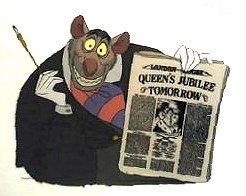
![]() Ratigan was the late Mr. Vincent Price (1911-1993), who is very well-known
in classic horror films, such as The House of Wax (1953), The
Raven (1963), The Fly (1958), and The House on Haunted Hill
(1958). More interestingly, he played wonderful supporting characters
in Otto Preminger's Laura (1944), Cecil B. DeMille's The Ten
Commandments (1956) and Tim Burton's Edward Scissorhands (1990).
Ratigan was the late Mr. Vincent Price (1911-1993), who is very well-known
in classic horror films, such as The House of Wax (1953), The
Raven (1963), The Fly (1958), and The House on Haunted Hill
(1958). More interestingly, he played wonderful supporting characters
in Otto Preminger's Laura (1944), Cecil B. DeMille's The Ten
Commandments (1956) and Tim Burton's Edward Scissorhands (1990).
![]() The Great Mouse
Detective is the 31st animated
feature film released by Disney, based on the children's book series by
Eve Titus, Basil of Baker Street. The books were about a little mouse living
the life and career of his idol, Sherlock Holmes! With his loyal partner
and friend, Dr. David Q. Dawson, they investigate the crimes of London.
The Great Mouse
Detective is the 31st animated
feature film released by Disney, based on the children's book series by
Eve Titus, Basil of Baker Street. The books were about a little mouse living
the life and career of his idol, Sherlock Holmes! With his loyal partner
and friend, Dr. David Q. Dawson, they investigate the crimes of London.
![]() Disney's talking
mouse film was supposedly released to coincide with Steven Spielberg and
Don Bluth’s An American Tail.
Disney's talking
mouse film was supposedly released to coincide with Steven Spielberg and
Don Bluth’s An American Tail.
![]() After the box
office failure of another Spielberg film, Young Sherlock Holmes,
the Disney marketing department deemed the title of the original source
novel, Eve Titus’ Basil of Baker Street, as sounding too "British"
for a so-called kids movie, and straddled it with probably the generic
and unimaginative title The Great Mouse Detective. Angry at what
amounted to a slap in the face of their creativity and artistry, an anonymous
animator posted a gag memo in the Studio at that time, claiming that all
the previous animated features were going to be renamed with similar, simplistically
ridiculous monikers, such as Seven
Little Men Help a Girl, The Wooden
Boy Who Became Real and my personal favorite, A
Boy, A Bear and a Big Black Cat.
After the box
office failure of another Spielberg film, Young Sherlock Holmes,
the Disney marketing department deemed the title of the original source
novel, Eve Titus’ Basil of Baker Street, as sounding too "British"
for a so-called kids movie, and straddled it with probably the generic
and unimaginative title The Great Mouse Detective. Angry at what
amounted to a slap in the face of their creativity and artistry, an anonymous
animator posted a gag memo in the Studio at that time, claiming that all
the previous animated features were going to be renamed with similar, simplistically
ridiculous monikers, such as Seven
Little Men Help a Girl, The Wooden
Boy Who Became Real and my personal favorite, A
Boy, A Bear and a Big Black Cat.

![]() When Disney re-released the movie years later they gave it the title of
The
Adventures of the Great Mouse Detective. When the film was released
on video a few months later, the title on the box was back to The Great
Mouse Detective but the title on the film itself read The Adventures
of the Great Mouse Detective.
When Disney re-released the movie years later they gave it the title of
The
Adventures of the Great Mouse Detective. When the film was released
on video a few months later, the title on the box was back to The Great
Mouse Detective but the title on the film itself read The Adventures
of the Great Mouse Detective.
![]() After a four-year
period of story development, animation took just over one year to complete.
This remarkably short production span was possible due to new efficiencies
in the production process (such as video tests and computer-assisted layouts
and graphics), and an increased emphasis on story development prior to
the start of production.
After a four-year
period of story development, animation took just over one year to complete.
This remarkably short production span was possible due to new efficiencies
in the production process (such as video tests and computer-assisted layouts
and graphics), and an increased emphasis on story development prior to
the start of production.
![]() One hundred and
twenty five artists were involved in making the film.
One hundred and
twenty five artists were involved in making the film.
![]() An innovative
application of computer technology can be seen in the climactic scene where
Basil faces Ratigan in a final confrontation inside the turning and thrashing
gearworks of Big Ben. The 54 moving gears, winches, ratchets, beams, and
pulleys were literally drawn by the computer and create a unique background
for the characters, who had been animated in the usual way.
An innovative
application of computer technology can be seen in the climactic scene where
Basil faces Ratigan in a final confrontation inside the turning and thrashing
gearworks of Big Ben. The 54 moving gears, winches, ratchets, beams, and
pulleys were literally drawn by the computer and create a unique background
for the characters, who had been animated in the usual way.
![]() Employing for one of
the last times the time-honored animation style of its predecessors and,
for one of the first times, the then brand-new technique of computer animation
that would eventually become more and more commonplace, The Great Mouse
Detective, like its follow-up, Oliver
and Company, found itself on the cusp of the new wave in animated
films
Employing for one of
the last times the time-honored animation style of its predecessors and,
for one of the first times, the then brand-new technique of computer animation
that would eventually become more and more commonplace, The Great Mouse
Detective, like its follow-up, Oliver
and Company, found itself on the cusp of the new wave in animated
films
![]() Sherlock Holmes'
voice in the movie (a 25-second dialogue) is that of Basil Rathbone (1892-1967),
who portrayed Holmes for over 35 years! Disney used a sound-recording of
his Sherlock Holmes radio productions. However Nigel Bruce did not voice
Dr. John H. Watson, instead the voice was done by a Laurie Main.
Sherlock Holmes'
voice in the movie (a 25-second dialogue) is that of Basil Rathbone (1892-1967),
who portrayed Holmes for over 35 years! Disney used a sound-recording of
his Sherlock Holmes radio productions. However Nigel Bruce did not voice
Dr. John H. Watson, instead the voice was done by a Laurie Main.
![]() The box that the
white girl mouse cries on is "Gaston's Liver Pills", a reference to the
father of one of the artists.
The box that the
white girl mouse cries on is "Gaston's Liver Pills", a reference to the
father of one of the artists.
![]() When Basil is
with Olivia and they are on the trail of the one legged bat. You will find
Dumbo sitting on the shelf along with the other toys.
When Basil is
with Olivia and they are on the trail of the one legged bat. You will find
Dumbo sitting on the shelf along with the other toys.
![]() Shortly before
his death, Vincent Price (1911-1993) said that one of his most favorite
roles was the voice of Professor Ratigan, especially since two original
songs had been written for him.
Shortly before
his death, Vincent Price (1911-1993) said that one of his most favorite
roles was the voice of Professor Ratigan, especially since two original
songs had been written for him.
 |
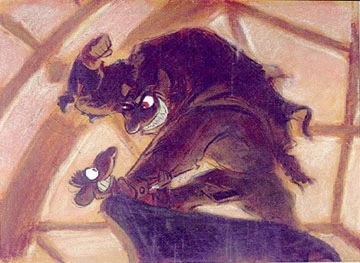 |
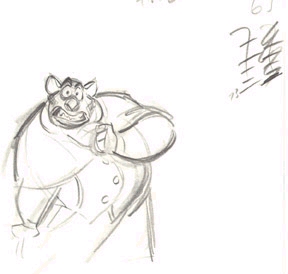 |
Just as The Black Cauldron (1985) had been the Sleeping Beauty (1959) of the new breed of animators, it needed to be followed by another 101 Dalmatians (1961). Just as Beauty had been a 70MM big budget disaster, so was Cauldron. And, just as Dalmatians had to prove that the animators could still make a popular movie and make it for a small amount of money, so The Great Mouse Detective had to save the floundering animation department and do it at the lowest cost possible.
During the mid-80s, there was quite a bit of change going on at Disney. Walt Disney Productions was now The Walt Disney Company and it had a whole new board of directors. One of the new regime, Jeffrey Katzenberg, had been responsible for the butchering of The Black Cauldron and he was in charge of film production. Why should the young animators put their trust in the man responsible for editing their first movie? Luckily, they were given the opportunity to be led by two of their own.
Ron Clements and John Musker, two animators who had quickly advanced through the ranks and were now in story, had written a treatment for an animated homage to Sherlock Holmes based on Eve Titus' Basil of Baker Street. The new management liked the idea of a more fun picture to follow the darkness of Cauldron and so, Ron and John were given the go-ahead to direct this new picture along with Dave Michener and Burny Mattinson.
 It
was a risky move to release this picture on the heels of Cauldron,
as it was also not of the traditional Disney ilk. Disney had never
before released a picture with such a tempo (except, perhaps for 101
Dalmatians). From the moment the picture starts, the story
draws the audience in and never stops until the story has ended.
There are no sequences which seem to go nowhere (a major problem in Cauldron)
and the songs, although certainly not classics when compared to most of
the Disney favorites, do their best to move the action along rather than
slowing it down. The script is strong, and the characters well developped.
The
Great Mouse Detective demonstrated that Disney feature animation was
already over its crisis and headed in the right direction.
It
was a risky move to release this picture on the heels of Cauldron,
as it was also not of the traditional Disney ilk. Disney had never
before released a picture with such a tempo (except, perhaps for 101
Dalmatians). From the moment the picture starts, the story
draws the audience in and never stops until the story has ended.
There are no sequences which seem to go nowhere (a major problem in Cauldron)
and the songs, although certainly not classics when compared to most of
the Disney favorites, do their best to move the action along rather than
slowing it down. The script is strong, and the characters well developped.
The
Great Mouse Detective demonstrated that Disney feature animation was
already over its crisis and headed in the right direction.
 Last
but not least, one of the greatest advantages this film has over The
Black Cauldron is the animation of Glen Keane. Since his
work on the bear in The Fox and the
Hound (1981), Keane had proven himself the most promising talent
among the new animators. His work on The
Black Cauldron had been cut and thus the picture did not carry
his name in the credits. With this film, Keane would be able to prove
his talent through the wonderfully wicked villain, Ratigan. A mixed
creation of the Clements/Musker script and Keane's wonderful imagination
and sense of character, Ratigan is the ideal villain for Basil. A
rat who is shamelessly attempting to pass himself off as a mouse ("A BIG
mouse!"), Ratigan is both cunning and feminine.
Last
but not least, one of the greatest advantages this film has over The
Black Cauldron is the animation of Glen Keane. Since his
work on the bear in The Fox and the
Hound (1981), Keane had proven himself the most promising talent
among the new animators. His work on The
Black Cauldron had been cut and thus the picture did not carry
his name in the credits. With this film, Keane would be able to prove
his talent through the wonderfully wicked villain, Ratigan. A mixed
creation of the Clements/Musker script and Keane's wonderful imagination
and sense of character, Ratigan is the ideal villain for Basil. A
rat who is shamelessly attempting to pass himself off as a mouse ("A BIG
mouse!"), Ratigan is both cunning and feminine.
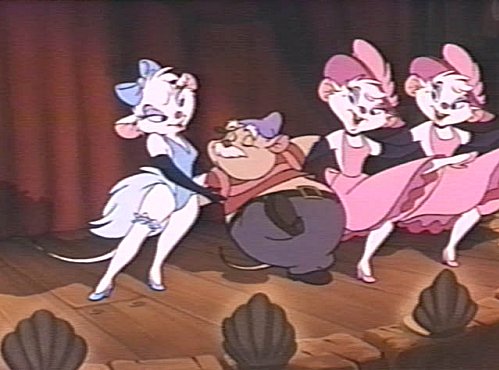 Henry
Mancini also contributed a great deal to the mood of this picture. Mancini
is well-known for his musical scores and he certainly does not disappoint
with this one. The animators, still looking for something new to
get them involved, weren't exactly thrilled by the prospect of working
with an old-Hollywood composer, but they wouldn't get to work with contemporary
music (if one overlooks the fact that then-contemporary artist Melissa
Manchester penned and performed "Let Me Be Good to You") until 1988's Oliver
& Company (1988). Just as a contemporary score was appropriate
for that film, so would it have been equally inappropriate for this one.
Henry
Mancini also contributed a great deal to the mood of this picture. Mancini
is well-known for his musical scores and he certainly does not disappoint
with this one. The animators, still looking for something new to
get them involved, weren't exactly thrilled by the prospect of working
with an old-Hollywood composer, but they wouldn't get to work with contemporary
music (if one overlooks the fact that then-contemporary artist Melissa
Manchester penned and performed "Let Me Be Good to You") until 1988's Oliver
& Company (1988). Just as a contemporary score was appropriate
for that film, so would it have been equally inappropriate for this one.
The story and planning took 4 years, but the actual "creating" took only 1 year. During the making, a vast majority of Disney's talent, time, money ($25 million, in fact, the world-record sum during the time for an animated feature) were concentrated on the epic animated film, The Black Cauldron; while a smaller crew worked on a different feature with a much smaller budget.
 The
Great Mouse Detective is a film which did not strive to make a mark.
It did not take any risks in its animation style. Nevertheless, this
is the first Disney animated film to use computer generated animation.
With this film, Disney began a history of most often using computer animation
to enhance, not take away from, the characters and plot. In July
1986, in a big shadow of the most expensive feature's critical and huge
box-office failure the previous year, The Great Mouse Detective
received warm reviews and nice financial success.
The
Great Mouse Detective is a film which did not strive to make a mark.
It did not take any risks in its animation style. Nevertheless, this
is the first Disney animated film to use computer generated animation.
With this film, Disney began a history of most often using computer animation
to enhance, not take away from, the characters and plot. In July
1986, in a big shadow of the most expensive feature's critical and huge
box-office failure the previous year, The Great Mouse Detective
received warm reviews and nice financial success.
|
||||||||||||